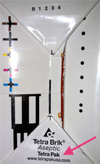Bisphenol A, or BPA, is a chemical used to make a hard clear plastic called polycarbonate, some sealants, and thermal paper such as the paper used to print cash register receipts.
Most of us living in the United States have BPA in our bodies, but the human health effects are unknown. Our main sources of BPA are household products. Today, fewer products contain BPA than in 2010 because of efforts by Washington State, federal agencies and some product manufacturers.
What products have BPA?
BPA enters our bodies mainly through food and beverages that have been in contact with polycarbonate.
- Canned foods, because most metal cans are lined with a sealant containing BPA.
- Sports water bottles may contain BPA if bought before July 2012.
- Baby bottles, sippy cups and other containers designed for children 3 years old and younger may contain BPA if bought before July 2011.
- Baby pacifiers
 Other hard, clear plastic food or beverage containers. This symbol means it may contain BPA.
Other hard, clear plastic food or beverage containers. This symbol means it may contain BPA. - Cash register receipts. Some manufacturers make “BPA free” thermal paper, but it’s often coated with a chemical called BPS. According to a 2014 report from the EPA, BPS may pose health hazards similar to BPA because the two chemicals are structurally alike and BPS is also easily transferred to skin.
BPA-free products

- Glass and stainless steel containers with no plastic linings.
- Brick-shaped cardboard cartons (like juice boxes) used for food packaging. Cartons made by Tetra Pak or SIG Combibloc do not contain BPA. Look for those names on the bottom of the carton.
 Plastic containers labeled with a 1, 2 or 5.
Plastic containers labeled with a 1, 2 or 5.
But beware:
Four reasons "BPA-Free" won't protect you
BPA-Free Plastic Containers May Be Just as Hazardous
The concerns about BPA
Human exposure to BPA is widespread. A survey of the U.S. population found BPA in 93 percent of urine samples from people age 6 and older. 1
"... any level of exposure at all—may cause endocrine or reproductive abnormalities ..."
The U.S. Food and Drug Administration (FDA) and the National Toxicology Program agree that recent studies provide reason for some concern about the potential effects of BPA on the brain, behavior, and prostate gland of fetuses, infants and children. 2
Reduce your exposure to BPA
Find tips to reduce infant’s exposure to BPA.
The best way to reduce your BPA exposure is to avoid household products that contain BPA.
Food choices:
- Eat fresh and frozen foods instead of foods stored in cans.
- Purchase foods packaged in glass containers, ceramic containers or cardboard brick-shaped cartons. Juice boxes are an example of a cardboard brick-shaped carton. Look on the bottom to see if it was made by Tetra Pak or SIG Combibloc.
Food containers already at home:
- Replace pre-2011 baby bottles, sippy cups, water bottles and other hard, clear plastic food storage containers. 3
- Throw away cracked or scratched plastic containers. Recycle them if possible (ask your local recycling program) or put them in garbage.
- Use glass or unlined stainless steel water bottles.
- Keep plastic containers labeled with a 1, 2 or 5; they do not contain BPA or other plastic chemicals of concern.

- Dispose of plastic containers labeled with a 7 inside the recycle symbol. Although not all 7 plastics contain BPA, it’s not easy to tell which contain BPA and which don’t.
Safer practices for food containers made of polycarbonate:
- Use polycarbonate plastic for cold storage and for non-food items.
- Heat food in glass, ceramic or stainless steel containers. In polycarbonate containers, heat leaches more BPA into foods and liquids.
- Wash polycarbonate containers by hand instead of in the dishwasher to prevent scratching. Scratching releases more BPA.
Safer practices for receipts:
- Wash your hands after handling receipts
- Consider putting gloves on before handling a lot of receipts
More information
- National Institutes for Environmental Health Sciences (NIEHS)/National Toxicology Program (NTP): Since You Asked: Bisphenol A
- FDA: Bisphenol A Fact Sheet
- Washington State Department of Ecology: Bisphenol A
- Washington State Department of Health: Bisphenol A
- EPA Action Plan: Bisphenol A Action Plan Summary
1. U.S. Centers for Disease Control and Prevention, The 2003-2004 National Health and Nutrition Examination Survey
2. U.S. FDA, Bisphenol A (BPA): Use in Food Contact Application
3. Before July 2011, some retailers voluntarily sold BPA-free products. If you know your plastic food containers are “BPA-free,” continue to use them. Otherwise, we recommend replacing them.